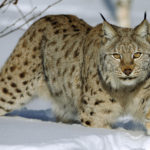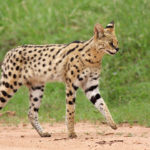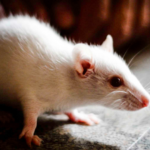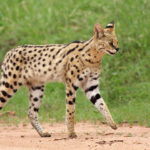Lynx
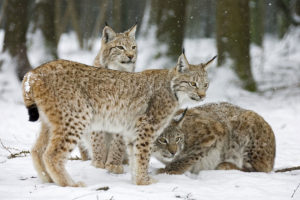 Lynxes are large predators, which, despite their size, are closely related to common wild cats and domestic cats. In total, there are 4 species of lynx – common, Canadian, red and Spanish. These species are similar in appearance and way of life.
Lynxes are large predators, which, despite their size, are closely related to common wild cats and domestic cats. In total, there are 4 species of lynx – common, Canadian, red and Spanish. These species are similar in appearance and way of life.
The appearance of lynxes is quite different from other species of felines. These are animals the size of an average dog: body length can reach up to 1 m, weight from 5-7 kg (in red lynx) to 12-20 kg in other species. The trunk of these animals is relatively short, and the paws are long and broad at the same time. The distinctive features of these cats are a short thick tail and large ears with tufts of wool at the ends. On these grounds, one can immediately distinguish the trot from the rest of the feline.
Fur in all species of lynx is quite thick, on the cheeks long hair forms “whiskers”. Color of the coat red or gray with black or brown spots. In contrast to the leopard, the spots in the lynx are rare and distributed evenly throughout the body. The tip of the tail is always black.
The area of these animals is located in the Northern Hemisphere – lynx can be found on the expanses of Europe, Asia and North America. In the north, the zone of distribution of lynx reaches the polar circle, in the south it borders on the subtropics. All kinds of lynx are forest dwellers and only red lynx can be found in deserts in the south of the USA. Ordinary and Canadian lynx prefer to live in coniferous forests, the Spanish lynx inhabits the dry evergreen forests of the Pyrenees mountains. These animals lead a solitary life. They are silent, unsociable and rarely come to people’s attention. Due to its broad paws, the lynx does not get stuck when moving in deep snow. Lynxes lead a sedentary life, but the common lynx can make migrations after mass multiplying rabbits.
Southern species of lynx (Spanish, red) prey mainly on rodents, hares, rabbits and birds. Ordinary and Canadian lynx also often include in their diet larger animals – deer, young elks and wild boars. It is not force, but hunting tactics that helps them to kill prey much larger than themselves. Lynxes prefer to watch their victim in ambush or sneaking up, then jump to the victim with a sudden jump on his back and choke. They show great caution and endurance, hanging out for a long time in ambush (sometimes the whole day).
However, sometimes lynx hunts for hares in vzagon. In addition to herbivorous animals, trotters can also eat small predators – martens, foxes, wild cats and even wolf cubs.
Lynx breeds once a year. The gon takes place in February-March. Males begin to make loud cries of call. Because lynxes live separately, they do not form clumps even during the breeding season. Pregnancy lasts 2-2,5 months. The female gives birth in a secluded den 2-3 kittens.
The mother carefully conceals her shelter and protects offspring from encroachments of other predators (while small kittens can be killed by wolves or large martens). Young lynxes stay with their mother until the spring of next year. Lynx in captivity live up to 25 years, and in nature only up to 15 years.
Throughout the range, lynxes are comparatively rare. In addition to the natural competition with other predators, they also suffer from poaching and habitat reduction. For hunters, the lynx has always been a valuable prey, because its fur is of very high quality. In the old days in Russia, lice were used even for food. Now the greatest fear is the fate of the Spanish lynx. Since this beast lives in a densely populated Iberian Peninsula, only about 150 individuals survived in the remote corners of mountain forests.
